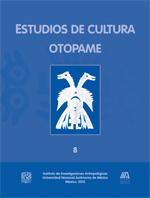Textile techniques and cultural history of otopame people
Main Article Content
Abstract
The list of plants and animals used as sources of fibers and dyes by Otopamean peoples in the late 1800s and the first half of the 20th century shows a marked preference for species of Neotropical affinity, which seems to indicate that the art of weaving was first developed in the lowlands of Mesoamerica. Otomí and Mazahua groups maintained the most diversified repertoire of techniques for the backstrap loom in Central Mexico, in the same way that the Oaxacan Otomangueans conserved the most varied textile technology in the region to the south. The Mexican rebozo, a nationalistic icon whose origin has been the subject of much debate, has antecedents in the ikat-dyed textiles of Otomí communities in the Mezquital valley and the Sierra Gorda. I relate the patterns of diversity which I have documented in this realm of material culture with the geographical location of the Otopamean peoples and their historical links with neighboring groups.

